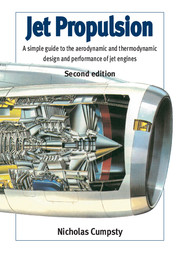 Jet Propulsion
Jet Propulsion Book contents
- Frontmatter
- Contents
- Preface
- Glossary
- Nomenclature
- Part 1 Design of Engines for a New 600-seat Aircraft
- 1 The New Large Aircraft – Requirements and Background
- 2 The Aerodynamics of the Aircraft
- 3 The Creation of Thrust in a Jet Engine
- 4 The Gas Turbine Cycle
- 5 The Principle and Layout of Jet Engines
- 6 Elementary Fluid Mechanics of Compressible Gases
- 7 Selection of Bypass Ratio
- 8 Dynamic Scaling and Dimensional Analysis
- 9 Turbomachinery: Compressors and Turbines
- 10 Overview of the Civil Engine Design
- Part 2 Engine Component Characteristics and Engine Matching
- Part 3 Design of Engines for a New Fighter Aircraft
- Part 4 Return to the Civil Transport Engine
- Appendix: Noise and its Regulation
- Bibliography
- References
- Index
- Design sheets for New Large Civil Aircraft and New Fighter Aircraft
3 - The Creation of Thrust in a Jet Engine
from Part 1 - Design of Engines for a New 600-seat Aircraft
- Frontmatter
- Contents
- Preface
- Glossary
- Nomenclature
- Part 1 Design of Engines for a New 600-seat Aircraft
- 1 The New Large Aircraft – Requirements and Background
- 2 The Aerodynamics of the Aircraft
- 3 The Creation of Thrust in a Jet Engine
- 4 The Gas Turbine Cycle
- 5 The Principle and Layout of Jet Engines
- 6 Elementary Fluid Mechanics of Compressible Gases
- 7 Selection of Bypass Ratio
- 8 Dynamic Scaling and Dimensional Analysis
- 9 Turbomachinery: Compressors and Turbines
- 10 Overview of the Civil Engine Design
- Part 2 Engine Component Characteristics and Engine Matching
- Part 3 Design of Engines for a New Fighter Aircraft
- Part 4 Return to the Civil Transport Engine
- Appendix: Noise and its Regulation
- Bibliography
- References
- Index
- Design sheets for New Large Civil Aircraft and New Fighter Aircraft
Summary
INTRODUCTION
The creation of thrust is the obvious reason for having engines and this chapter looks at how it occurs. This is a simple consequence of Newton's laws of motion applied to a steady flow. It requires the momentum to be higher for the jet leaving the engine than the flow entering it, and this inevitably results in higher kinetic energy for the jet. The higher energy of the jet requires an energy input, which comes from burning the fuel. This gives rise to the definition of propulsive efficiency (considering only the mechanical aspects) and overall efficiency (considering the energy available from the combustion process).
MOMENTUM CHANGE
The creation of thrust is considered briefly here, but a more detailed treatment can be found in other texts, for example Hill and Peterson (1992). Figure 3.1 shows an engine on a pylon under a wing. Surrounding the engine a control surface has been drawn, across which passes the pylon. The only force applied to the engine is applied through the pylon. We assume that the static pressure is uniform around the control surface, which really requires that the pylon is long enough that the surface is only weakly affected by the wing. In fact we assume that the wing lift and drag are unaffected by the engine and the engine unaffected by the wing; this is not strictly true, but near enough for our purposes.
- Type
- Chapter
- Information
- Jet PropulsionA Simple Guide to the Aerodynamic and Thermodynamic Design and Performance of Jet Engines, pp. 25 - 29Publisher: Cambridge University PressPrint publication year: 2003
- 1
- Cited by


